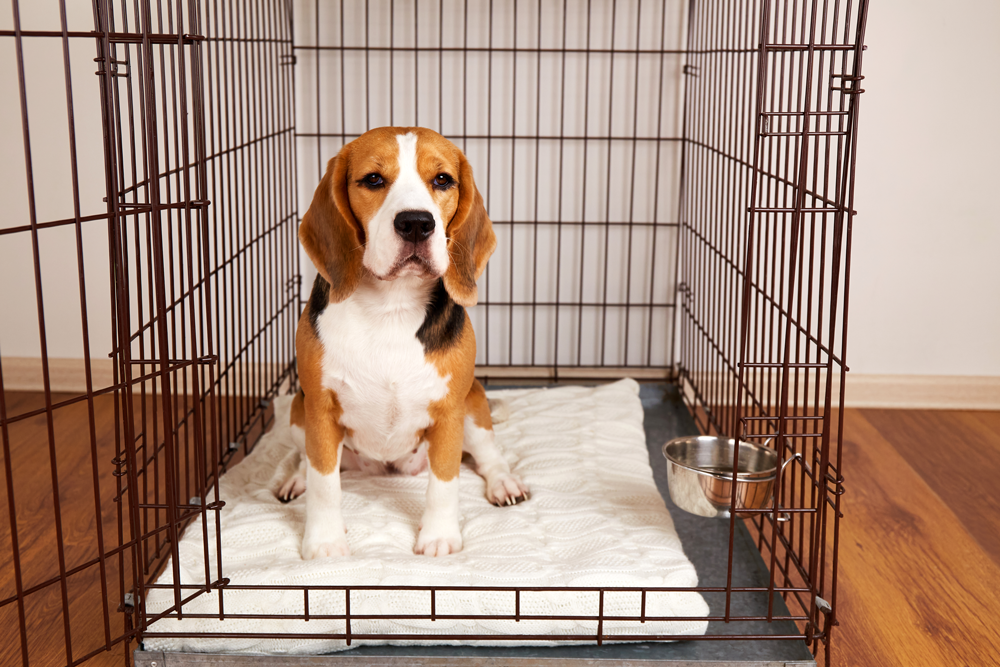Crate training is an essential element of dog and puppy training, focused on making the crate a happy, safe spot for them. Done the right way, crate training isn’t punishment but an effective tool within a balanced approach, offering great benefits for your dog’s happiness.
A Safe Haven for Your Dog
Tapping into your dog’s natural instinct to have a den, a crate can serve as a modern “den”—a personal sanctuary providing security and comfort. Feeling safe like this really helps your dog feel happy and settled.
Getting them to love the crate means introducing it gently and managing it well:
- Setup: Choose a crate large enough for your dog to stand, turn, and lie down comfortably, but not so large (especially for puppies) that it allows for eliminating in one end and sleeping in the other. Furnish it with soft, familiar bedding to make it feel like a comfy nook. Place it in a common area, avoiding temperature extremes, but it is recommended to move the crate occasionally (for example, a bedroom or loungeroom) so the dog learns it’s safe anywhere.
- Positive Introduction & Initial Steps: You really want your dog to connect the crate with positive experiences from the very beginning.
- Start simply by letting your dog investigate the open crate. Toss high-value treats near it, then just inside the door, then further back, encouraging curiosity without stress.
- Begin feeding your dog their meals inside the crate with the door open initially, allowing them to enter and leave freely. For puppies, this might be three times a day.
- Use treats to lure the dog fully inside. As they enter, use a clear, simple and consistent marker word (“Crate,” “Yes”) the moment they step in, immediately followed by the treat reward inside the crate.
- Keep these initial sessions super short (seconds to a minute) and aim to wrap it up on a high note, before the pup starts getting stressed. The goal is for the dog to enter willingly and feel comfortable.
- Gradual Conditioning to Confinement: You should only start conditioning them to the door being closed once they enter the crate happily.
- Start by closing the door for just 5-10 seconds while the dog is calm (perhaps eating a treat), then immediately open it before they get anxious. Reward quiet behaviour.
- Slowly increase the duration of the door closure over many sessions, always ensuring the dog remains calm and relaxed. Avoid long confinement periods during these initial training phases.
- Management & Routine: Aim to crate your dog when they are calm, perhaps after quiet activity or a walk. Whatever you do, don’t use the crate when they’ve been naughty, especially during initial training, as this may create fear and defeat its purpose as a safe haven. Set up a consistent schedule for naps and overnight sleeping if applicable, reinforcing the crate as their safe spot for naps and sleep.
Nipping Bad Habits in the Bud
Crate training works well to stop destructive behaviours like inappropriate chewing or digging, particularly with puppies or when you can’t watch them like a hawk!
- Safety & Management: The crate keeps them safely contained, preventing access to dangerous things (cords, poisons) and protecting household items when you can’t supervise. This is vital for puppy-proofing.
- Interrupting Habits: It prevents undesirable behaviours (like chewing your new cushions!) becoming self-rewarding habits because they simply don’t get the chance.
- Slowly Giving More Freedom: As your dog matures and they’ve earned your trust, you can slowly increase unsupervised time outside the crate based on consistent good behaviour.
- Separation Issues: For separation anxiety, a crate can be part of a management plan by providing a familiar space. In severe escape-focused cases, a sturdy crate might act as a management tool, though getting professional advice is important as confinement itself shouldn’t be the primary anxiety trigger.
- Know the Time Limits: Always make sure crate time is balanced with breaks for toileting, exercise, and interaction. The crate is a tool, not for leaving them alone and isolated for ages (see duration guidelines below).
Reducing Anxiety and Stress
A positive association with the crate makes it super helpful for handling stress from noise phobias, new environments, or separation. It acts as their safe retreat and helps manage anxiety in several key ways:
- Creating a Safe Haven: It becomes a den-like space where the dog feels secure, tapping into their natural instinct. When things get stressful (storms, visitors), a crate-comfortable dog can choose to retreat there to feel safer.
- Managing Arousal Levels: The crate helps them learn the difference between activity and rest, especially for high-energy dogs. Teaching the dog that the crate is for calming down helps stop them getting too worked up, which can sometimes manifest as anxious behaviours.
- Preventing Escalation: Learning calmness within the crate can sometimes generalise, helping the dog manage anxiety in other situations and environments. It provides a foundation for teaching self-regulation.
- Facilitating Recovery: When they have to be confined (like vet visits or post-surgery), a dog comfortable with crating feels less stressed overall because the crate itself isn’t scary for them.
- Building Coping Skills: Experiencing different stimuli while secure in their crate (if it’s occasionally moved to various safe locations in the home) helps dogs build resilience and learn to cope with novelty without becoming overwhelmed.
- Tips for a calming crate environment:
- Always link the crate with good experiences through feeding or special treats given only in the crate.
- Let them go in on their own during stress; never force a fearful dog inside.
- Consider partially covering the crate (ensuring air flow) for a more secure feel.
- Playing calming music or white noise can mask external stressors.
- Stay calm yourself – your dog picks up and mirrors your emotional state.
- Do not release your dog for crying or demanding attention, as this reinforces the behaviour. However, always meet their genuine needs, especially scheduled toilet breaks for puppies.
- If anxiety is severe or panic occurs, get help from a qualified dog training professional for behaviour modification assistance.
Toilet Training Assistance
A crate is a big help for toilet training by using their natural instinct to keep their den (bed) clean. A correctly sized crate limits space, encouraging them to hold on and stopping accidents when you’re not watching. Success comes down to sticking to a strict schedule with frequent outdoor toilet opportunities (especially upon waking, after meals/naps, before bed), rewarding outdoor success immediately, and giving any indoor accidents a proper clean with an enzyme cleaner (no getting angry!). Remember puppies need shorter crate durations than adults; adjust timings based on age and individual progress.
How Long Is Too Long?
Once adjusted:
- Adult Dogs: Overnight crating (6-8 hours) is often acceptable if needs are met beforehand.
- Daytime Crating: Needs to be balanced with enough breaks for toileting, exercise, and interaction. Monitor your dog’s comfort.
- Puppies: Require much shorter durations initially, gradually increasing with age and bladder control (use the rule of thumb: one hour max per month old, to start with).
Prioritize your dog’s well-being. If you’re worried about how long or see signs of stress, talk to a qualified trainer.
Wrapping Up
Good crate training gives you lots of advantages: helping with toilet training, stopping destructive habits, giving them a crucial safe place, and easing stress. It takes patience, sticking with it, and really committing to positive association. Crate training, done correctly, isn’t about confinement but about raising a dog who feels secure and happy, and being a responsible dog owner.

